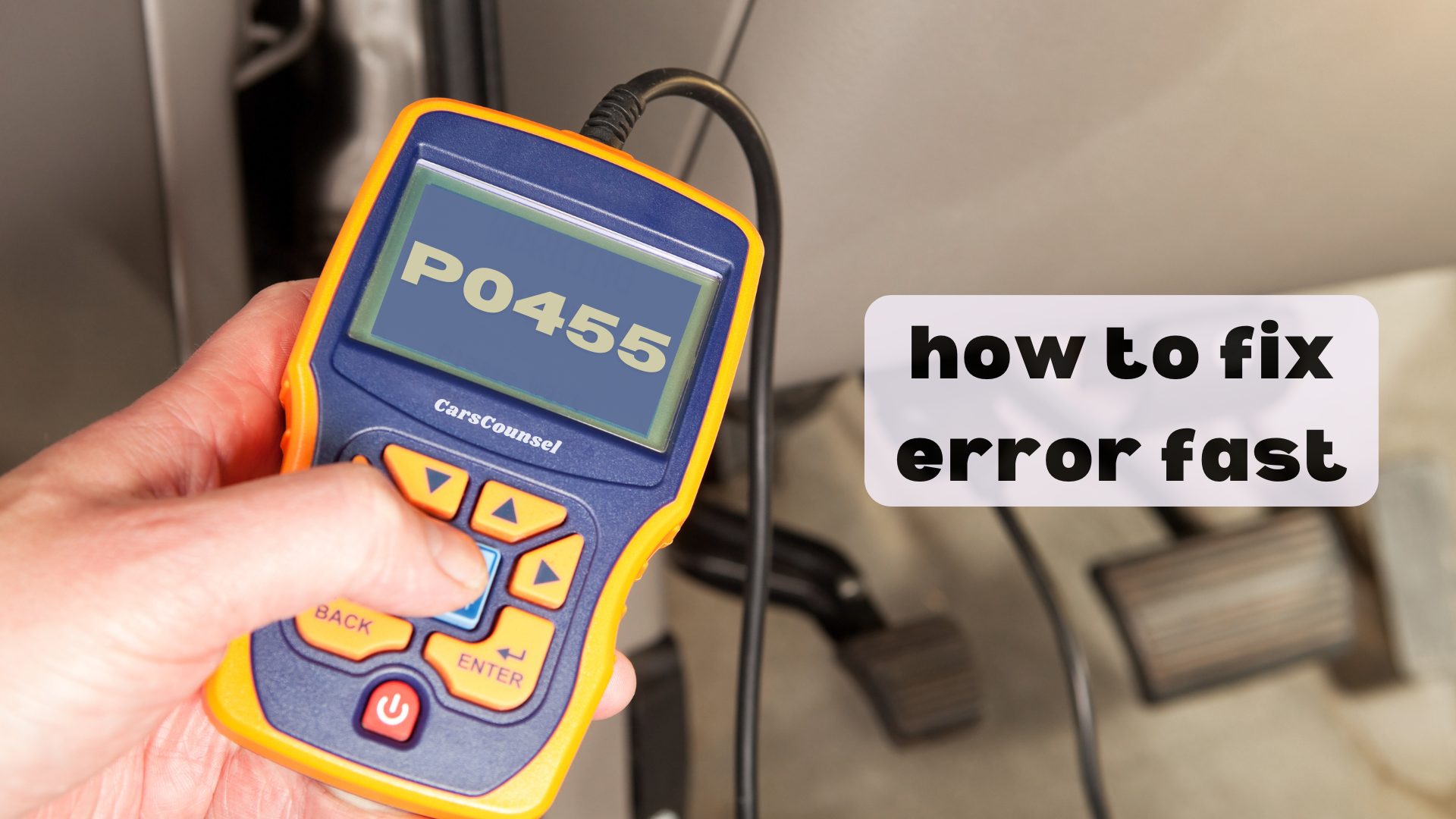You’ve just been confronted with the P0455 code on your dashboard, and you’re wondering what it means and what’s next. Fundamentally, this code indicates a significant leak in your evaporative emission control system, which is responsible for capturing and storing fuel vapors. This leak can lead to decreased fuel efficiency, reduced power, and even environmental harm.
But what’s causing the issue? Is it a simple fix, like a loose gas cap, or something more complex, like a faulty charcoal canister? In effect, you’ll need to dig deeper to find the root of the problem and get your vehicle running smoothly again.

Quick Navigation
Key Takeaways
- A P0455 code indicates a gross leak in the evaporative emission control system, which can lead to increased emissions and decreased fuel efficiency.
- Common causes of a gross leak include a loose gas cap, damaged hoses, and a faulty charcoal canister.
- Symptoms of a gross leak may include decreased fuel efficiency, reduced vehicle performance, and an illuminated “Check Engine” light.
- Diagnosis involves a visual inspection of the system, leak detection methods, and checking for tight connections and damage to components.
- Repair costs vary depending on the cause, but can range from $50 to $500 or more, and may require specialized tools and expertise.
Code Description and Meaning
The P0455 code is a trouble code that indicates a gross leak in the evaporative emission control system.
This system captures and stores fuel vapors to prevent atmospheric release. As you know, a large leak can lead to increased emissions and negatively impact your vehicle’s performance and fuel efficiency.
In terms of System Overview, the evaporative emission control system is designed to minimize the release of fuel vapors into the atmosphere.
Emission Basics dictate that fuel vapors must be captured and stored to prevent pollution. The system is an essential component of your vehicle’s emission control system, and a gross leak can have serious consequences if left unaddressed.
Causes of the P0455 Code
Since you’re dealing with a P0455 code, your vehicle’s evaporative emission control system likely has a gross leak, which can lead to increased emissions and negatively impact your vehicle’s performance and fuel efficiency.
This leak can be caused by a variety of factors, including a loose gas cap, damaged hoses, or a faulty charcoal canister.
The leak detection methods used by your vehicle’s onboard computer can detect even the smallest leaks, which is why it’s essential to address this issue promptly.
A gross leak in the evaporative emission control system can significantly impact your vehicle’s fuel efficiency, leading to decreased mileage and increased fuel costs.
Symptoms and Effects
When your vehicle’s evaporative emission control system springs a gross leak, you may notice some telltale symptoms.
The most noticeable effect will be a decrease in fuel efficiency, as the leak allows fuel vapors to escape, reducing the amount of fuel available for combustion.
Additionally, you may experience a decline in vehicle performance, such as reduced power and acceleration.
The leak can also cause your “Check Engine” light to illuminate, indicating a problem with the emission control system.
If left unaddressed, the issue can lead to a failed emissions test, further compromising your vehicle’s performance and fuel efficiency.
Diagnosis and Testing
To diagnose the P0455 code, you’ll need to pinpoint the source of the gross leak in your vehicle’s evaporative emission control system.
Start by performing a visual inspection of the system, looking for signs of damage, cracks, or loose connections in the hoses, fuel tank, and charcoal canister.
Use leak detection methods such as a smoke test or a pressure test to identify the source of the leak.
System inspection tips include checking the fuel cap for tightness and ensuring all connections are secure.
Be thorough and methodical in your inspection, as a small leak can be difficult to find.
Repair Options and Costs
Once you’ve identified the source of the leak, it’s time to weigh your repair options.
The cost of repairing a P0455 code varies depending on the specific cause and labor rates. If the issue is a loose gas cap, the fix is simple and inexpensive.
However, if the problem lies with a faulty charcoal canister or damaged hoses, the repair estimates will be higher.
Cost factors to ponder include the type of repair, labor costs, and the cost of replacement parts.
On average, repair costs can range from $50 to $500 or more, depending on the extent of the damage.
It’s essential to get a detailed estimate from a qualified mechanic to determine the best course of action for your vehicle.
Technical Notes and Insights
Now that you’ve investigated your repair options and costs, it’s time to dig deeper into the technical aspects of the P0455 code.
Understanding the EVAP System Design is vital in diagnosing the issue. The system is designed to capture and store fuel vapors, preventing atmospheric release.
Leak Detection Methods are also essential in identifying the source of the problem. The control module uses various sensors and monitoring systems to detect even the slightest leaks.
A gross leak, as indicated by the P0455 code, can be caused by a variety of factors, including a loose gas cap, damaged hoses, or a faulty charcoal canister.
Importance and Difficulty Levels
One key aspect to ponder when tackling a P0455 code repair is the importance and difficulty levels of the task.
You’ll want to understand the repair importance level, which is rated as 1 (Low), indicating that the issue isn’t pivotal but still requires attention.
The repair difficulty level is rated as 3 (Hard), suggesting that you may need specialized tools and expertise to fix the problem.
A leak detection importance analysis reveals that the EVAP system’s ability to capture and store fuel vapors is compromised, which can lead to increased emissions and decreased fuel efficiency.
A thorough repair complexity analysis is essential to identify the root cause of the issue and develop an effective repair strategy.
Additional Resources and Information
Dig deeper into the P0455 code by exploring additional resources and information that can aid in your diagnosis and repair.
You can access factory service manuals that provide detailed information on fixing the P0455 code. These manuals will give you a comprehensive understanding of the EVAP system and its components, helping you identify the root cause of the issue.
Additionally, online forums and repair communities can offer valuable insights and experiences from other users who’ve faced similar problems. By leveraging these resources, you’ll be better equipped to diagnose and repair the P0455 code efficiently and effectively.
More OBD-II Codes
Frequently Asked Questions
Can I Drive My Car With a P0455 Code?
You can drive your car with a P0455 code, but be aware that it may affect your fuel economy and driving habits, potentially leading to decreased performance and increased emissions, so it’s recommended to address the issue promptly.
Will a P0455 Code Cause My Car to Stall or Shut Down?
You won’t typically experience stalling or shutdowns due to a P0455 code, but it can lead to issues like fuel pressure fluctuations or vacuum leaks, which might cause poor engine performance, rough idling, or decreased power, so it’s essential to address the underlying leak promptly.
Can a P0455 Code Be Triggered by Extreme Weather Conditions?
As you navigate through temperature fluctuations and humidity effects, you may wonder if extreme weather conditions can trigger a code; yes, they can, as moisture and heat can expand and contract system components, potentially revealing hidden leaks.
Is a P0455 Code Specific to Certain Vehicle Makes or Models?
You’ll find that the P0455 code is not specific to certain vehicle makes or models, as emission regulations dictate that all vehicles must have an evaporative emission control system, making vehicle compatibility universal across the board.
Can a P0455 Code Be Cleared With a Simple Reset or Reboot?
As you reboot your time machine, you wonder if a simple reset can clear the code; however, a P0455 code typically requires a thorough diagnosis with a scan tool to identify the faulty sensor or leak, rather than a quick reboot solution.
Conclusion
You’ve now gained a comprehensive understanding of the P0455 code, its causes, symptoms, and repair options. Remarkably, the Environmental Protection Agency estimates that a single loose gas cap can cause up to 22 tons of evaporative emissions per day. Don’t let a simple fix like tightening your gas cap go unnoticed, as it can significantly impact the environment and your vehicle’s performance.

